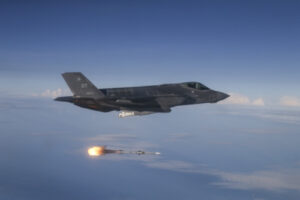Defense Daily
-
 Air Force
Air ForceBussiere: USAF Bomber Fleet Availability ‘In the 50s’
The percentage of U.S Air Force bombers available for missions is in the 50s—a trend consistent with service-wide aircraft availability statistics, Gen. Thomas Bussiere, the head of Air Force Global […]
-
Thursday, May 22, 2025
- Driscoll: Army Transformation Plan May Save $48 Billion Over Five Years For Reinvestment
- NGA, Space Force Agree On Roles And Responsibilities For TacSRT
- USAF Examining Follow-On to Airborne Launch Control System
- Ultra Maritime and General Atomics Partner For Anti-Sub Offerings
- NGA Developing New Project Around Non-Standard Mission Planning
- Maven Makes Its Way Into U.S. Transportation Command
- U.S. Space Force Assessing What Rights It Must Retain for Golden Dome
- Ursa Space Nabs NGA Luno A Task Order; Univ. of Illinois Gets High-Performance Compute Award
- Acting USCG Commandant Lunday Nominated To Serve as Commandant Amid Massive Organizational Changes
- Flight Test For W87-1 Planned For Next Calendar Year, Sandia Says
- Savannah River Pit Facility Design 90% Complete in 2026, NNSA Exec Says
- Air Force Conducts Minuteman III Test Launch
-
Thursday, May 22, 2025
- NGA, Space Force Agree On Roles And Responsibilities For TacSRT
- Driscoll: Army Transformation Plan May Save $48 Billion Over Five Years For Reinvestment
- USAF Examining Follow-On to Airborne Launch Control System
- U.S. Space Force Assessing What Rights It Must Retain for Golden Dome
- NGA Developing New Project Around Non-Standard Mission Planning
- Maven Makes Its Way Into U.S. Transportation Command
- Savannah River Pit Facility Design 90% Complete in 2026, NNSA Exec Says
- Acting USCG Commandant Lunday Nominated To Serve as Commandant Amid Massive Organizational Changes
- Flight Test For W87-1 Planned For Next Calendar Year, Sandia Says
- Ultra Maritime and General Atomics Partner For Anti-Sub Offerings
- Ursa Space Nabs NGA Luno A Task Order; Univ. of Illinois Gets High-Performance Compute Award
- Air Force Conducts Minuteman III Test Launch
-
 Air Force
Air ForceUSAF Examining Follow-On to Airborne Launch Control System
The U.S. Air Force is examining industry capacity to build “secondary launch capability”–a follow-on to the Airborne Launch Control System (ALCS) on the U.S. Navy’s E-6B Mercury Take Charge and […]
-
 Uncategorized
UncategorizedAir Force Conducts Minuteman III Test Launch
A team from the Air Force Global Strike Command (AFGSC) launched an unarmed Minuteman III intercontinental ballistic missile Wednesday at 12:01 a.m. Pacific Time from Vandenberg Space Force Base, Calif., […]
-
 Space
SpaceUrsa Space Nabs NGA Luno A Task Order; Univ. of Illinois Gets High-Performance Compute Award
ST. LOUIS—Ursa Space Systems this week received a $13.8 million task order for the Global Oil Awareness Tracker (GOAT) under a commercial data analytics contract focused on facility monitoring and […]
-
 Army
ArmyDriscoll: Army Transformation Plan May Save $48 Billion Over Five Years For Reinvestment
The Army estimates its new transformation plan could save $48 billion over the next five years that it would reinvest in higher priority areas, according to the service’s civilian leader. […]
-
 Space
SpaceNGA, Space Force Agree On Roles And Responsibilities For TacSRT
ST. LOUIS—The National Geospatial-Intelligence Agency (NGA) and the U.S. Space Force on Wednesday signed a memorandum of agreement (MoA) clarifying their respective roles and responsibilities in carrying out tactical surveillance, […]
-
 Uncategorized
UncategorizedActing USCG Commandant Lunday Nominated To Serve as Commandant Amid Massive Organizational Changes
In addition to spelling out her vision for sweeping organizational changes, Department of Homeland Security Chief Kristi Noem on Wednesday announced that Acting Coast Guard Commandant Adm. Kevin Lunday has […]
-
 Space
SpaceU.S. Space Force Assessing What Rights It Must Retain for Golden Dome
The U.S. Space Force is analyzing how to retain control over key elements of Golden Dome amid a possible bid by a SpaceX team to lease equipment to DoD for […]


